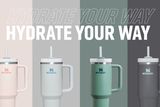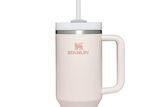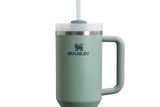The Stanley Cup craze: How the ‘ugly’ over-sized cup went from rock bottom sales to a viral bestseller
It’s the drinking vessel that you’re seeing on social media, in your office and at the gym. So why has the camping flask — designed over 100 years ago – suddenly caught the zeitgeist?



It all started with a car crash. On November 15, 2023, TikTok user Danielle Marie Lettering posted a video showcasing the aftermath of her car catching on fire. The video, filmed on her phone, centres on the car’s front seats, burned and flaking from excessive heat. The outer layer of the Kia steering wheel is peeling. Lettering’s voice, however, is upbeat. “Everybody is so concerned about if the Stanley spills,” she says, her hand reaching into the wreckage to lift her intact Stanley Quencher tumbler, nestled between both burnt seats. “But what about this…” she says, lifting it and shaking it, the familiar tinkle of ice cubes ringing through.
“There was a fire in this place yesterday, and it still has ice in it.” The video shot into virality (at the time of writing, it had over 96 million views). When Stanley president Terence Reilly saw it, he reached out to Lettering to send her some new tumblers and to replace her car on behalf of the brand. His video response, also shared to TikTok, garnered over 32 million views, quickly becoming the feel-good story of the season and causing the cups to sell out across the States and beyond. “The emotional support water bottle that keeps giving,” one poster wrote in the comments. “I’m buying a Stanley,” wrote another.
The Stanley Quencher H2.0 is a quintessentially American vessel: an oversized accessory for those in oversized cars. The Quencher comes in various sizes, but the 40oz style — recently restocked in Brown Thomas and Arnotts in four colours at €55 each — is the most popular. The cup sits snugly inside most car cup holders, features an oversized handle and is claimed to keep drinks hot for five to seven hours or cold for nine to 11 hours.
Read more
Though its rip-roaring success is recent, its production is not; William Stanley invented the steel vacuum-sealed bottle in 1913. In the century since, “his vacuum bottle evolved from concept to icon and has become an essential part of workdays, road trips and outdoor adventures,” the company says. It historically targeted workmen and those participating in outdoor activities, like camping and hiking, in its marketing.
Because of this, Stanley cups resided within the realms of barbecue dads. In fact, in 2019, the 40oz Quencher was selling so poorly that the company had stopped restocking or marketing it. Then, Terence Reilly happened. Reilly, the former chief marketing officer of Crocs, joined Stanley in the spring of 2020, in the hopes of recreating what he did with the US foam footwear company: making the uncool, cool. At Crocs, he had launched celebrity collaborations with Justin Bieber, SZA and Diplo, linking the shoes with trendsetters and billionaires. From 2018, stocks at the footwear company began shooting upward, helming itself on one crucial thing: that its former negative reputation was seen as an asset.
At Stanley, Reilly followed a similar playbook. In 2020, he worked with Buy Guide, an affiliate marketing site based in Utah, to harness the brand’s popularity with Mormon mom-fluencers, launching a system wherein they could make money by driving sales. In July of 2023, the brand launched its first celebrity collaboration, with country musician Lainey Wilson, who produced a pink-and-green Watermelon Moonshine Quencher, named after one of her songs. It sold out in 11 minutes.
"It’s amusing to see obsession grow around a product that was once considered ugly."
The rejigging of established brands into viral digital content machines is not new. The Stanley cup resurge came at a time one might call The Great Hydration, wherein the average person was told they weren’t drinking enough water. It’s a tactic that sold bottled water, and pushed forward the need for ‘motivational’, water bottles, which displayed phrases like: “Drink your effing water!” to “All in a day’s work”. Vessels like these nudge us to imagine hydration as a goal and remind us that it can be a social joy. That, paired with the health panic that came with the global pandemic, allowed water drinkers to commit to a careful self-management, and control in an uncontrollable time.
We need your consent to load this Social Media content. We use a number of different Social Media outlets to manage extra content that can set cookies on your device and collect data about your activity.
Indeed, the reusable water bottle craze was never just about our physical needs, or the planet’s — achieving peak hydration offers a sense of control in an uncertain world. When insecure, humans have an uncanny ability to allow objects to fill the void. First, it was sheet masks, now, it is Stanley cups. As journalist Amanda Mull, of The Atlantic, recently put it, “Sometimes a cup is just a cup in the right place at the right time.”
It’s amusing to see obsession grow around a product that was once considered ugly. On Instagram, the hashtag #stanleycup sees fans of the vessel pose with the product in a number of ways; ironically at dance practice; earnestly in their Cadillacs; in memes with the caption “Stay hydrated!” An interesting element to the craze is that both the social-media literate and average Joe can enjoy this trend together.
The problem, of course, is that we have hit peak Stanley cup, and things can only go down from here. (FYI, Owala is the next big thing in water bottles. Something I never thought I‘d write…)
Join the Irish Independent WhatsApp channel
Stay up to date with all the latest news


















